May 2022
Posted: 5/31/2022 2:16:32 PM
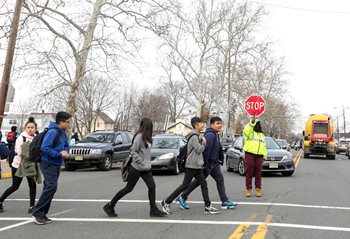 Twenty-two communities in the NJTPA region will receive a combined $13.8 million in grants under the state’s Safe Routes to Schools Program.
Twenty-two communities in the NJTPA region will receive a combined $13.8 million in grants under the state’s Safe Routes to Schools Program.
The New Jersey Department of Transportation (NJDOT) announced the funding May 31 as part of a larger $19.6 million award to 31 municipalities statewide.
“The Safe Routes to School program is a great example of how NJDOT, working with the state’s three regional planning authorities, helps our communities access federal funding for local transportation projects,” said NJDOT Commissioner Diane Gutierrez-Scaccetti, who serves on the NJTPA Board of Trustees. “These grants will provide resources to improve sidewalks and bike paths to encourage children to stay active by walking and biking to school.”
NJDOT administers the program in partnership with the NJTPA and the two other metropolitan planning organizations that represent the state, the Delaware Valley Regional Planning Commission and the South Jersey Transportation Planning Organization.
Safe Routes to School is a federally funded program that aims to increase pedestrian safety and encourage children to walk and bike to school. Projects are designed to improve safety while also reducing traffic, fuel consumption and air pollution near schools. This can include constructing sidewalks; pedestrian and bicycle crossing improvements; installing bike lanes; and new crosswalks.
Special consideration was given to applications that addressed equity by providing benefits to underserved communities, low-income residents, minorities, those with limited English proficiency, persons with disabilities, children, and older adults.
Click here to view the 2022 grant awards.
Posted: 5/26/2022 2:54:54 PM

The NJTPA hosted its 8th Annual Tech Tools for Planning Expo on May 19, showcasing three tools: the NJTPA's Equity Analysis Tool, New Jersey's Potential Lead Exposure Map tool; and the City of Tacoma, Washington's Equity Index.
“Equity really is just an incredibly important consideration in our region, we have a very diverse population of 7 million, with, of course, very diverse needs when it comes to planning and transportation,” said David Behrend, NJTPA Deputy Executive Director, noting that equity is a focus of the NJTPA’s recently adopted Long Range Transportation Plan, Plan 2050: Transportation. People. Opportunity.
Gabrielle Fausel, a Principal Planner in GIS and Planning Tools, presented the NJTPA’s new Equity Resources website, built on the Esri Hub platform, and Equity Analysis Tool, which is modeled after a similar tool the Delaware Valley Regional Planning Commission developed. The tool allows users to quickly identify where different populations live in a project area, municipality, or county.
She said the NJTPA developed the tool in response to requests for data and guidance on how to analyze equity considerations when launching a new study. The tool includes data on the location of minorities, low-income individuals, limited English proficiency, people with disabilities and other factors. The website brings together various resources, like guidance documents the NJTPA has developed and information on federal requirements.
“It’s our hope that our resources, like the new Equity Analysis Tool, will help our own staff and our partners better understand these populations so that the potential benefits and impacts of projects and programs can be considered in our planning work,” Behrend said.
Christine Schell, Program Manager of New Jersey Department of Environmental Protection’s Office of Environmental Public Health and Safety, presented on the Potential Lead Exposure Map, which created in partnership with the New Jersey Department of Health. The tool is being released in phases. The first phase, released in October, focuses on lead-based paint in homes, which poses the greatest risk of lead exposure to children and families.
“It is envisioned that the tool will grow as a one-stop mapping tool that uses publicly available data to give a sense of where potential lead sources are that are affecting human health in New Jersey,” Schell said.
Additional data being considered for future phases include school and daycare center drinking water sampling results; soil lead levels; information on abandoned sites; and lead service line locations.
Jacques Colon, Strategic Manager for the City of Tacoma, presented on the city’s Equity Index. The tool helps determine where community members are unable to access services, or where services do not meet the community’s needs. It compiles 29 different indicators — such as life expectancy, road quality, air quality, unemployment, poverty rates and access to healthy food — into one tool that generates scores for each Census block ranking them from very low to very high levels of inequity.
Colon said the beauty of the tool is its ability to analyze various data sources and present patterns.
“It doesn’t tell the full story to look at any single piece of data; really it requires us looking at the full comprehensive conglomeration of indicators,” he said.
Colon said the city uses the index to identify and track disparities; support data-driven decision-making; and to provide transparency and accountability of that process.
Additional information about the tools and speaker bios are available on the event page. A recording of the event is available below.
Posted: 5/24/2022 3:53:58 PM
The pre-application process for the Transportation Alternatives Set-Aside (TA Set-Aside) Program is open through September.
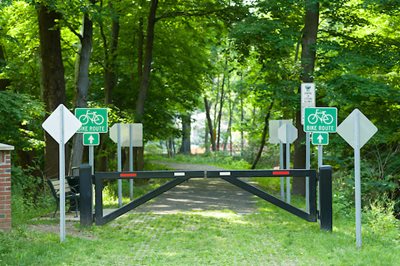 Funded through the Federal Highway Administration’s Federal Aid Program, the TA Set-Aside Program is administered by the New Jersey Department of Transportation (NJDOT) in partnership with the NJTPA and the state’s other two metropolitan planning organizations. Anyone interested in applying for funding must schedule a pre-application meeting.
Funded through the Federal Highway Administration’s Federal Aid Program, the TA Set-Aside Program is administered by the New Jersey Department of Transportation (NJDOT) in partnership with the NJTPA and the state’s other two metropolitan planning organizations. Anyone interested in applying for funding must schedule a pre-application meeting.
The program has been used to fund streetscape improvements, rails-to-trails, and Morris Canal Greenway segments, among other things.
Sascha Frimpong, Director of Local Project Development at the NJTPA, gave an overview of the program at the May 18 Morris Canal Working Group meeting, encouraging members to begin preparing applications.
The TA Set-Aside Program provides funding for a number of different activities, such as:
- Design and construction of on- and off-road trail facilities for pedestrians, bicycles, and other nonmotorized forms of transportation;
- Construction of overlooks, scenic turnouts, and viewing areas;
- Rehabilitation and historic preservation of historic transportation facilities, including canals and buildings;
- Conversion of abandoned railroad corridors for trails for pedestrians, bicyclists, and other nonmotorized transportation;
- Streetscaping and corridor landscaping;
- Environmental mitigation to address stormwater management, control and water pollution prevention or abatement related to highway construction or due to highway runoff; and,
- Reduce vehicle-caused wildlife mortality or restore and maintain connectivity among wildlife habitats.
With the Infrastructure Investment and Jobs Act (IIJA) approved, it’s very likely that additional funding is coming into the program, Frimpong said, although at this point, it’s unclear how much. The NJDOT would like to open another solicitation this calendar year. Applicants must have maps, brief descriptions and cost estimates for projects completed prior to scheduling a meeting.
Any projects moving forward also should be submitted to the public in some type of forum. That could be a public meeting, discussion at a local council meeting or public event, or with a community interest group, so feedback is received.
Posted: 5/24/2022 3:25:59 PM
Restoration of the Morris Canal’s Lock 2 East is an example of what supporters hope to achieve with the Morris Canal Greenway, with a tow path along the river where people can walk, hike and fish.
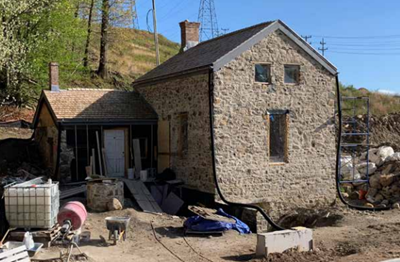 The 17-year project in Wharton is coming to fruition, according to Joe Macasek of the Canal Society of New Jersey. Last October, work began on the lock tender’s house, with reconstructed walls and a roof and since then lots of interior work has been done, said Macasek, who provided an update on progress along the canal to the Morris Canal Working Group during its virtual meeting on May 18.
The 17-year project in Wharton is coming to fruition, according to Joe Macasek of the Canal Society of New Jersey. Last October, work began on the lock tender’s house, with reconstructed walls and a roof and since then lots of interior work has been done, said Macasek, who provided an update on progress along the canal to the Morris Canal Working Group during its virtual meeting on May 18.
The Morris Canal runs 102 miles from Jersey City to Phillipsburg.
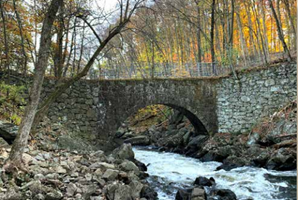 In Boonton, a partnership between the township, its trails committee and the Canal Society, has yielded a trail plan that will bring to use many of the canal assets, including a railroad trestle and rehabilitation of the Stone Arch Bridge. Macasek said they’re trying to work with a developer who has acquired acreage in Grace Lord Park to preserve some Ironworks features for the greenway, such as a retaining wall, which held battery pond of water power to run The Rolling Mill; a blacksmith’s shop; and the Esten House, the former Ironworks manager’s house, which they hope to save and make the center of a historic district. A new trail head and signage was installed and another three signs are in development for Ironworks.
In Boonton, a partnership between the township, its trails committee and the Canal Society, has yielded a trail plan that will bring to use many of the canal assets, including a railroad trestle and rehabilitation of the Stone Arch Bridge. Macasek said they’re trying to work with a developer who has acquired acreage in Grace Lord Park to preserve some Ironworks features for the greenway, such as a retaining wall, which held battery pond of water power to run The Rolling Mill; a blacksmith’s shop; and the Esten House, the former Ironworks manager’s house, which they hope to save and make the center of a historic district. A new trail head and signage was installed and another three signs are in development for Ironworks.
Further west, the Canal Society is working with the Township of Mount Olive to acquire Inclined Plane 3, near Route 80, which previously was owned by the International Trade Center. It had been offered as a donation years ago, Macasek said, but never quite could get accomplished until recently. Mount Olive acquired the property with some help from the Canal Society, he said, and the deal will be done after some environmental cleanup. Access to the site is not easy, Macasek added, but they will work with the township in the future to create practical public access.
In Warren County, there are Greenway trail improvements slated for Plane 9 West, Bread Lock Park, Port Murray, Florence Kuipers Park and Bilby Road. “Funding is going to bring those sections up to snuff,” Macasek said, and improve public access.
Macasek also encouraged attendees to take advantage of walking tour guides the Canal Society has developed, which are available on its website.
The Waterloo Valley Trail is probably the longest stretch of the Morris Canal Greenway, running about 5 miles from Waterloo Village to the Bilby Road, and one of the most walked sections of the Greenway along Musconetcong River, Macasek said. There’s a walking guide in the works that he hopes will be public this summer.
Macasek’s presentation and other meeting materials are available on the Working Group’s website.
Posted: 5/9/2022 4:26:11 PM
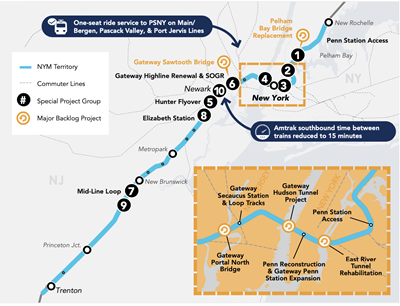 The Northeast Corridor (NEC) could soon be getting much needed upgrades thanks to the federal Infrastructure Investment and Jobs Act (IIJA), according to Mitch Warren, executive director of the Northeast Corridor Commission.
The Northeast Corridor (NEC) could soon be getting much needed upgrades thanks to the federal Infrastructure Investment and Jobs Act (IIJA), according to Mitch Warren, executive director of the Northeast Corridor Commission.
“It’s a busy, important and complex corridor and all those trains are operating over aging infrastructure; bridges and tunnels that are over 100 years old,” Warren told the NJTPA Board of Trustees during a presentation at its May 9 meeting. “There hasn’t been a significant investment in the corridor in most of our lifetimes.”
Warren outlined Connect NEC 2035 – The Future of the Northeast Corridor (C35), a 15-year service development plan and infrastructure planning process for the NEC, a 457-mile route between Boston and Washington, D.C. The corridor carries more than 800,000 primarily commuter passengers a day and 2,000 commuter, intercity and freight trains operated by nine different agencies, he said.
While C35 was developed before IIJA was developed, Warren called the timing “fortunate” because it presents an unconstrained list of projects and workforce needs that the commission can now seek funding for.
He said the plan will be updated so that the Federal Railroad Administration (FRA) has the latest information available to create its project inventory and award grants.
Within the New York City Metro Territory, the 274-page plan identifies $55 billion in infrastructure improvements over 15 years, including at least a half-dozen projects that will impact the NJTPA region:
- Penn Reconstruction and Gateway Penn Station Expansion reconstructs existing Penn Station New York to transform the outdated and over-capacity station, relieve overcrowding and be part of an integrated complex with Moynihan Train Hall and Penn Expansion. Expansion provides additional track and platform capacity to support growth in rail service, possible with the new Gateway Hudson Tunnels.
- Gateway Hudson Tunnel constructs a new two-track tunnel beneath the Hudson River and rehabilitates and modernizes the existing two-track North River Tunnel.
- Gateway Sawtooth Bridge replaces a pair of railroad bridges between Newark and Secaucus, N.J., in the Meadowlands with new structures to support a four-track segment with improved track speeds.
- Hunter Flyover constructs a flyover south of Newark Penn Station to eliminate at-grade crossings to reduce conflict between trains, increasing capacity for NJ TRANSIT and Amtrak, enabling NJ TRANSIT to improve Raritan Valley Line service.
- Mid-Line Loop eliminates at-grade movements that create conflicts, increasing capacity, and improving reliability. This would enable the New Jersey High-Speed Rail Program’s goal of 160 MPH speeds on Acela and support enhanced NJ TRANSIT service.
- Gateway Secaucus Station and Loop Tracks expand the Secaucus Station platform system and add loops at Secaucus Junction. This will allow a one-seat ride to Manhattan from New Jersey’s Hudson and Bergen counties and New York’s Rockland and Orange counties via Metro-North service operated by NJ TRANSIT.
The Northeast Corridor Commission, which was created by Congress, allocates some $1.3 billion a year in shared operating and normalized replacement capital costs that helped create some stability to the corridor’s funding levels, according to Warren. The 18-member commission includes a representative from each of nine states, and nine more representing Amtrak and the U.S. Department of Transportation, bringing together the states and federal government in a collaborative partnership. New Jersey’s representative is Kevin Corbett, CEO and President of NJ TRANSIT.
“It was important to our members who are investing more in the corridor that the federal government also step up and invest more,” he said noting that states alone can’t afford the significant improvements needed. “Fortunately with the infrastructure bill … we now do have a great partnership on its way with the federal government.”
The biggest challenge has always been money, but significant limitations also include the workforce and getting track time, Warren said, noting, “It’s such a busy corridor.”
While ridership is down, most agencies are close to pre-pandemic service levels, so most of the movement is back. Warren said even if there was unlimited funding, improvements would be constrained by the ability to take tracks out of service to make repairs. C35 presents a plan for getting the “maximum productivity out of each track outage.”
Infrastructure issues, such as failures of track and communications and signals systems, are consistently the main cause of delays on the NEC. “It’s not going to be fixed overnight, it’s going to take years,” Warren said. “As we replace these aging bridges and tunnels, as we renew the track infrastructure to modernize signal systems, the electric catenary system, we’re going to see significant reliability improvements.”
He said planning work will help minimize the short-term pain caused by taking track offline to make these repairs.
While he said Congress has provided more consistent funding over the past decade, historically Amtrak was on the brink of bankruptcy. He called the passage of the IIJA last year a game changer. “It’s not enough for everything that needs to be done in the next 15 years but it’s an important start."